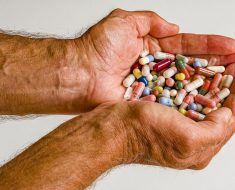As the suicides of Kate Spade and Anthony Bourdain show, rich and successful people can deal with the same anxiety and depression as everyone else.

Last Tuesday, award-winning fashion designer Katherine Noel Brosnahan — known best as Kate Spade — took her own life at her home in New York City. She was 55.
On Thursday, the government agency that tracks health epidemics reported that suicide is increasing all over the United States. It couldn’t pinpoint any single explanation behind suicide.
On Friday, celebrated American chef, author, and television star Anthony Bourdain died by an apparent suicide in his hotel room in France. He was 61.
Bourdain worked in the back of the house in many restaurants before making a name for himself with his best-selling first book, “Kitchen Confidential,” in 2000. On the heels of that, he became a globe-trotting chef and journalist, going to war-torn countries, tropical paradises, and even back to the kitchens where his career started. He overcame some early setbacks, including drug addiction, and rose to fame for his cooking, travels, and overall observations about what being human truly meant.
Spade began her fashion empire by first constructing her simple designs using cardboard and tape. Soon, her name grew into an iconic brand, offering bags and other accessories at both affordable and haute couture pricing. In 2016, Spade and her partners launched yet another bag and shoe brand, Frances Valentine. All the while, she was dealing with anxiety and depression.
Spade and Bourdain aren’t the first seemingly well-to-do people to end their lives when everything seems to be going in their favor.
They do, however, continue to add to the conversation about issues surrounding mental health.
As these recent cases illustrate, no one — regardless of status or wealth — is immune from mental health issues.
The successes Spade and Bourdain created made them the envy of millions. From the outside, that might seem like enough. But experts say it’s not.
A dark shadow
Allison Gervais, a psychotherapist working in the San Francisco Bay Area — “a mecca for high-functioning adults with tremendous pressure” — says someone who’s doing well financially or often in the spotlight can still live with depression, anxiety, low self-worth, and loneliness.
So, why, even with all their resources, would they have to “fake it” from the outside?
“Fear,” Gervais told Healthline. “Fear of losing jobs, fearing what others would think, fear of appearing weak or incapable, fear of letting others down, and fear to talk about it due to mental health stigma.”
It’s not as if Spade, Bourdain, and other notable celebrities were selected from an elite pool of humans prepared to handle the spotlight and their own mental health.
More often than not, celebrities are average people who have worked hard to get to the top.
Through their climb, they’ve faced obstacles, criticisms, and all the other problems other people face.
Add the pressure of celebrity to common mental health issues, such as anxiety and depression, and it casts a dark shadow on the glamorous celebrity lifestyle.
Judi Cinéas, PhD, a psychotherapist and licensed clinical social worker who works in the affluent “bubble” of Palm Beach, Florida, says being famous can mean a person loses their right to everyday human emotions.
Their success can mean they don’t “get to have” problems like the average American.
“The high performers are under great pressure to continue to excel. The higher they are, the greater the pressure to keep excelling,” Cinéas told Healthline. “There is also the threat to consistently be a cut above, because there are many others lined up and waiting for the opportunity to take the spot. Sadly, many face this pressure alone.”
A national epidemic
But when it comes to being at risk of suicide, celebrities are far from alone.
Just a day before Bourdain died while filming for his latest travel show in France, the Centers for Disease Control and Prevention (CDC) released a report showing suicide is increasing in nearly every state.
In 2016, 45,000 Americans age 10 or older died by suicide. This makes suicide the 10th-leading cause of death in the United States.
“Suicide is a leading cause of death for Americans — and it’s a tragedy for families and communities across the country,” Dr. Anne Schuchat, the CDC’s principal deputy director, said in a statement. “From individuals and communities to employers and healthcare professionals, everyone can play a role in efforts to help save lives and reverse this troubling rise in suicide.”
The CDC reports that more than half of people who died by suicide didn’t have a known, diagnosed mental health condition at the time of death.
No single factor will make someone suicidal. Any combination of physical health, relationship, job, money, legal, or housing problems — especially if combined with substance use — can increase a person’s risk for suicide, the CDC reports.
Copycat concerns
While not every suicide gets a headline, the deaths of people such as Spade and Bourdain are a notable event.
But, groups such as the American Association of Suicidology warn of how the deaths are covered. This includes omitting details of the means of death for public safety concerns, mainly to avoid being replicated by copycats.
Stephen P. Hinshaw, PhD, a professor of psychology at the University of California at Berkeley and professor of psychiatry at the University of California at San Francisco, says there can be some contagion — such as teens copying cutting behavior from peers — or glamorization related to celebrities, but he argues the antidote is to open the topics up for real discussion.
“First, we all need to talk about stress, mental health issues, and suicide. Tragically, the chokehold of shame and stigma still exist,” Hinshaw told Healthline. “We know far more facts about mental health issues than 60 years ago, but attitudes are far slower to change.”
Natasha Tracy, author of “Lost Marbles: Insights Into My Life with Depression and Bipolar,” says she believes that being in the spotlight can worsen mental health issues.
“It’s very difficult to maintain a certain appearance at all times when what you’re feeling inside is suffering. It’s also difficult to constantly watch what you do and say in fear of being attacked by fans, reporters, and the like,” she told Healthline. “These situations can definitely be stressors for some, and this can definitely take a toll on someone’s mental health.”
Asking for help
Tracy says the deaths of Spade and Bourdain — two individuals who had access to the best help in the world — makes it’s clear how hard it is to ask for help when someone is struggling.
“Your average person can be further disadvantaged as help can be much harder for them to get, and thus they may similarly not reach out when they need to,” she said. “When you are struggling with thoughts of suicide, it can absolutely feel impossible to vocalize it, but if someone actually approaches you out of love and asks if you need help, it can be the opening of a door that can save a life.”
The main takeaway, Tracy says, is that it’s everyone’s job to check in with our loved ones when we know they’re struggling and try to ensure that help is sought whenever possible.
As reports of these public deaths made it through the news cycle, many people offered respects and shared their thoughts to people they’d never met. There was a sense of kinship, whether it be a handbag they adored or a show that inspired them to travel and be more adventurous with their food.
YouTube star and activist Hannah Hart may have put it the best: Suicide has nothing to do with money, brilliance, or your career successes.
“It’s about managing your mental health: a constant and tedious task for those of us living with mental illness,” she tweeted. “Only you can know how much you can take, how much you can give. Only you can know your limits. You must honor and respect them. Life is ever-changing. Death is permanent. Stay gentle out there.”
If you or someone you know is contemplating suicide, call the National Suicide Prevention Lifeline at 800-273-8255. There’s someone available to listen 24 hours every day.
Source: Read Full Article





